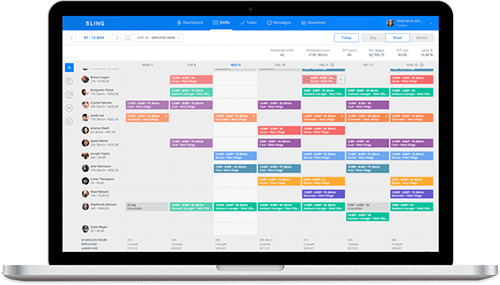How to Create an Effective Performance Improvement Plan
Want to build an effective team and make your business the best it can be? Imple...

As an owner or manager, you should always be looking for ways to improve the way you work. But that’s only half the equation for a successful business. You also need to focus on areas of improvement for employees.
Granted, every business is different, and what works for one team (or employee) might not work for another. But there are some universal skills that everyone — and we mean everyone — can stand to improve.
In this article, the management experts at Sling show you 29 areas of improvement for employees and how you can leverage them to make your business more productive.

Unless you have the perfect employee on staff, we’re sure you’ll be able to find at least one area of improvement for each member on your team. Use these in conjunction with periodic performance reviews to make sure your employees are working to their full potential.

Time management is crucial to your business’s success. Without it, few tasks would get done on time (if at all). That could be disastrous for everyone involved.
The best solution to this problem is to incorporate scheduling software, like Sling, into your daily routine. Sling not only helps you schedule when your employees are going to work, but it also provides a cloud-based to-do list with customizable deadlines and reminders that will keep everyone on task.
Organization can make time management much easier. When you and your employees are organized, you’ll know what needs to be done — and in what order — to get the task at hand accomplished.
Encourage your employees to create a daily schedule of the top three or four tasks (in order of priority) that they need to focus on. Then help them stick to that list until it’s finished.

It doesn’t matter if you manage a restaurant, a coffee shop, or a call center, you and everyone else who works there can all stand to improve interpersonal communication.
Even if it’s just between team members, being clear and direct in what you say (without offending) will improve the way you work like few other suggestions on this list.
Good customer service is the cornerstone of every great business. Even if your business already has a reputation as a customer-friendly establishment, this is one area of improvement for employees that you can never spend too much time on.
One of the best ways to improve your employees’ customer service skills is to demonstrate it in all you say and do. Then encourage your employees to follow your lead.
Unless your employees work by themselves, they’re going to have to cooperate with others at some point. And for your employees to operate at their full potential and overcome the obstacles in their paths, they’re going to need the help and cooperation of those on their team.
Conflict among employees is bound to happen even in the most well-adjusted teams. Sometimes, the stress just overwhelms and friction produces a flame.
It’s usually the manager’s job to put out the fire of conflict, but if you can train your employees to resolve their own disagreements, it will benefit your business 100-fold.

Effective listening — not just hearing — is essential for communication and the success of your business.
When you foster mature listening skills in all your employees, their productivity will increase, they’ll make fewer mistakes, and they (and your customers) will be much happier.
It’s true that technology has made communicating with others faster and easier. So much so that we tend to rely on it for everything. That technology, though, can’t make your employees’ writing better. Sure, it can help catch small spelling and grammar mistakes, but it can’t improve the quality and clarity of their words.
If your business relies on written communication, consider creating an internal style book for your employees to use when they’re composing. Make that style guide available to everyone (perhaps in the employee handbook) and encourage your team members to refer to it whenever possible.
Unless you’ve got a perfect employee working with you (in which case, we’re going to poach him or her from you), everyone will benefit by learning new skills. Doing so not only stimulates thinking and creativity, but it also increases the employee’s value to your business.
With new skills, you can use team members in different capacities, and they won’t be a “one-trick pony” who is only good at one thing.
To help your employees stretch and grow in the way they work, encourage them to set and strive to meet new goals.
A surefire way to help your team members reach their goals is to create an employee development plan they can follow. The development plan acts as a road map of sorts that shows team members the steps they need to take to succeed.
Feedback and constructive criticism are critical components of improving the way your employees work. Without it, no one would know what they’re good at and what they’re not good at.
But accepting feedback and constructive criticism can be difficult sometimes. Especially when your employees are giving their best. Do your part to make feedback and criticism as painless as possible, but train your employees to accept the advice with an open mind.

A big part of your job as a manager is to keep your team focused and engaged. But your employees can learn how to improve their productivity and work performance on their own.
There are plenty of strategies they can employ (many of them the same as you would use) to keep themselves motivated and on track to succeed.
We all think we have patience. That is, until work gets difficult and we begin losing our cool at the smallest problem.
If you see your employees facing this situation more often than not, don’t despair. You can encourage them to improve their patience with a little practice.
When you feel like they might be on the verge of losing their cool, instruct them to close their eyes, breathe deeply, and slowly count to 10 in their head. This simple technique can help them restore their patience during even the most trying of circumstances.
Sympathy, in many ways, is similar to compassion toward another person.
If an employee is having a hard time accepting the behavior of a coworker during a difficult time in their life, encourage them to try to put themselves in the other person’s shoes.
Once they understand what their coworker is going through, they can begin to see things from a new perspective. This helps them see why their coworker may be distracted at work, making more mistakes than usual, or getting irritated easily.
Your employee will realize that these negative traits are not the new norm. The behavior is just a reaction to an extreme situation. Give them the space and support they need and they’ll return to normal soon.

Whether your employees are dealing with customers or coworkers, flexibility is an essential trait for all.
At its core, flexibility is about realizing that there are multiple ways to complete any job. It’s also about being able to adjust quickly to whatever circumstances present themselves.
For example, employee 1 may complete a task with a specific set of steps (e.g., A then B then C then D) while employee 2 may choose to complete the task with a different set of steps (e.g., A then C then D then B).
Employee 1’s way may be more efficient, but it’s the results that really matter, not the way you obtained them. Help the employee see that it’s the outcome that counts, and they’ll be more flexible about the process.
As to the second part of flexibility — adjusting quickly — it’s vital in business that your employees aren’t so set in their ways that they can’t deal with a problem that wasn’t on their to-do list.
There will always be issues that pull your team away from their plans. Encourage them to be flexible, deal with the matter, and then return to what they were doing before.
Working in a business — as an owner, a manager, or an employee — is all about trust.
Owners have to trust that their managers will guide the business to success. Managers have to trust that their team will do what’s best for the business, even without supervision. And employees have to trust that management will support them when work gets difficult.
Everyone can build trust by always doing what they say they’ll do and fulfilling expectations, no matter how difficult it may be.
When everyone in your company — from the bottom to the top — trusts each other, the work environment will be much happier, the customers will notice, and business will improve.

Interest in others means connecting with them on a personal level. The easiest way to do that is by talking to other people and really getting to know them.
Help your employees convey genuine interest in others by giving them this three-step process:
During the conversation, they should make mental note of names, dates, and important events in the other person’s life. This may require that they keep track of pertinent information (i.e., write it down) so they can bring it up later and ask more questions.
Good judgment improves when you look at the world around you, listen to what others say, and learn from that information.
At first, good judgment may feel like an inborn “gut feeling” about what to do or how to react in certain situations. In many regards, this is true.
But your employees can improve their judgment by listening to their “intuition” while at the same time thinking rationally about why they feel the way they do.
Leadership is an integral part of all business activities. You need to exhibit leadership amongst your team. And your team members need to exhibit leadership within the group itself.
Some people are born leaders, while others have to work at it. Regardless of where your employees fall on that spectrum, you can improve their leadership by encouraging them to practice the following skills:
Like all the other areas on this list, the more your employees practice the better they’ll be. So give them time to practice their leadership skills and you’ll see your business improve.
Honesty means telling the truth in good situations, bad situations, and when it’s not in your best interest to do so.
When everyone on your team is honest in everything they do, the way they deal with each other will improve and they’ll draw closer together. This, in turn, will foster trust and help them conquer any problem that comes their way

In many ways, respect is one of the core areas of improvement for employees. And, really, the concept is simple: Treat others the way you would like to be treated.
To help employees improve in this area, pose the following question and see how they respond: If you had a problem, would you want to be dismissed or ignored? Chances are, they’ll say, “No, I wouldn’t want to be dismissed or ignored.”
Explain to them that the same goes for a customer or client who comes to them to resolve an issue. This is the start of developing respect for others.
Encourage the employee to work on being respectful at all times — regardless of the other person’s attitude — by exhibiting the following behaviors:
It can be difficult to show respect in tense, stressful, and antagonistic situations. But, when your employees focus on doing so, your business will be better for it.
Showing respect in tense, stressful, and sometimes antagonistic situations requires that your employees exercise self-control no matter what’s going on around them.
Granted, most people your team members interact with are going to exercise self-control as well — they’ll keep their voice low, remain calm, and do their best to communicate in a rational way.
But some people that your team members interact with will do the opposite: raise their voice, get excited (even angry), and not make a lot of sense when they talk.
Some customers or clients will insult the employee directly. It’s these latter situations that will demand strong self-control from your team.
Keep in mind — and help your employees understand as well — that the other person may just want to be heard and that this is the only way they know to make that happen.
Staying calm and exercising self-control allows the customer or client to vent their negative emotions without making the situation any worse. In fact, just letting the other person vent may work to resolve the issue completely.
Granted, it can be difficult to stand there, take verbal abuse, and say nothing, but doing so can benefit all parties involved.

The last few areas of improvement for employees have all revolved around the concept of empathy: being able to sense and understand the emotions of others.
Empathy is very similar to sympathy (mentioned earlier in this article) in that it involves putting oneself in the emotional space of the other person. But the two concepts differ in that empathy is being more aware of another person’s feelings rather than your own feelings.
At its most basic, empathy is the ability to understand the emotions of another person (e.g., this person is frustrated because they can’t find a way to get what they need by a certain deadline).
Sympathy, on the other hand, is a feeling you share with another person (e.g., you’re sad because the other person is sad).
In a business setting, empathy goes a long way toward helping your employees understand what your customers and clients need and how your business can help them solve their problems.
Attentiveness is important among the areas of improvement for employees because it applies to so many situations — with both customers and team members alike.
Exercising attentiveness means that your employees:
When your employees are attentive and focus on the person that’s speaking — be it you, their teammates, a customer, or a client — they’ll be better able to contribute to the conversation, express their own ideas, and help find solutions.
Determination is a key component of all business activity because it’s the drive to complete a task or resolve a problem regardless of how difficult the process becomes.
In a customer-facing situation, determination is the motivation to go above and beyond the status quo in order to provide an enjoyable and positive experience.
In an intra-business situation, it’s the motivation to tackle a problem and see it through to the end despite the work it might require.
Cultivate determination in your team and encourage them to maintain it when the going gets tough.

Helping your team maintain a positive attitude during the workday is crucial if you want your business to succeed.
A positive attitude expresses itself in everything your employees do — from dealing with customers to taking out the garbage to any other task they’re asked to perform. To encourage a positive attitude in your employees, don’t focus on the negative. Instead, focus on the positive.
For example, if your team is facing a difficult project or a looming deadline, generate a positive attitude by getting excited about finding new and unique solutions to common problems or working hard to finish everything before the deadline.
Doing so helps your team shift their perspective from viewing challenges as speed bumps or obstacles to viewing them as opportunities to excel.
And don’t neglect the fact that your positive attitude will most certainly rub off on your team. If you hold on to that “can do” attitude, your employees will, too.
No employee is an island. Working together in the same space — or even virtually — means that it’s all but certain one employee will approach another employee with a question, concern, or request.
For example, employee A may need to ask employee B about the progress of a certain task. How does employee B receive employee A? Will employee B — the one being approached — be brusque, irritable, and dismissive? Or will they be welcoming and approachable?
Being approachable, open, and welcoming, even when busy, is a quality that builds a strong sense of team throughout your business.
Train your team to do their best to give their full attention to anyone who comes to talk with them. And, again, consider the fact that many of these areas of improvement for employees start with you, their manager. If you’re approachable, your team will develop that skill as well.
Of course, this doesn’t mean that you and your employees have to stop what you’re doing to be available all the time.
There are times when it’s important to prevent interruptions. In those cases, train your team members how to deal with these situations — perhaps making an appointment to talk later — while still preserving the sense of camaraderie in the business.

Working in any type of business means dealing with and solving problems when they come up.
For example, a manager has to figure out how to best schedule their employees, how to set up and manage inventory, how to track employees’ work hours, and how to calculate payroll (just to name a few).
An employee has to figure out how to best interact with customers and clients, how to complete a given task successfully and to the standards of the business, and how to get along with their teammates.
Each and every one of these issues demands strong problem-solving skills. Without them, neither you nor your team would ever get anything done.
Train your employees to be proactive. Perhaps start by meeting to discuss ways to improve an existing workflow or what problems you can address before they become major issues.
Doing so can help “prime the pump,” so to speak, and strengthen an employee’s problem-solving skills for the betterment of your team and your business.
We discussed flexibility earlier in this list of areas of improvement for employees, and, at first glance, that trait and adaptability may seem like the same thing, but they’re actually very different.
Flexibility means:
Acknowledging that there are a number of ways to get things done
Adaptability, on the other hand, means:
Rolling with the changing circumstances
A high-performing employee needs to be able to adapt their actions to the problem at hand, the personalities of those with whom they interact, and a whole host of other variables.
And, in a very real sense, you want your team members to be able to adapt to new challenges and new opportunities. When you encourage your employees to be adaptable, you prepare them to handle anything your business throws at them.

Everyone in your business — including you — can improve on at least one skill from this list. In fact, you and your employees will probably identify several areas that deserve attention.
Don’t let your employees get overwhelmed if they find that they could, for example, stand to strengthen their positivity, honesty, and listening skills. They don’t have to tackle them all at once. Take it one step at a time.
Have them pick one skill they want to improve and work on it for as long as it takes to become habit. Then have them pick another skill and work on it until it becomes automatic.
![Two People]s feet standing on concrete that says Passion Led Us Here](https://getsling.com/wp-content/uploads/2019/09/areas-of-improvement-for-employees_5.png)
Whether you’re an owner, a manager, a team member, or all three, it’s vital to love what you do. If you don’t, it’s going to be difficult to generate the drive to improve. So find the joy in your job.
Once you’ve got that joy, it’s easier to identify your strengths and weaknesses. From there, you can take steps — or help your employees take steps — to learn, grow, and improve.
If you find it hard to carve out time for improvement, build learning blocks into your and your team’s schedule. Software like Sling makes this process simple.
Sling is a workforce management app with a heavy focus on scheduling, distribution, time tracking, and communication. Its core features include:
The Sling suite of tools incorporates all of these features into a cohesive scheduling tool that helps you create clear, easy-to-read schedules that you can post to the cloud for convenient storage and distribution.
For more free resources to help you manage your business better, organize and schedule your team, and track and calculate labor costs, visit GetSling.com today.
See Here For Last Updated Dates: Link
This content is for informational purposes and is not intended as legal, tax, HR, or any other professional advice. Please contact an attorney or other professional for specific advice.
Schedule faster, communicate better, get things done.